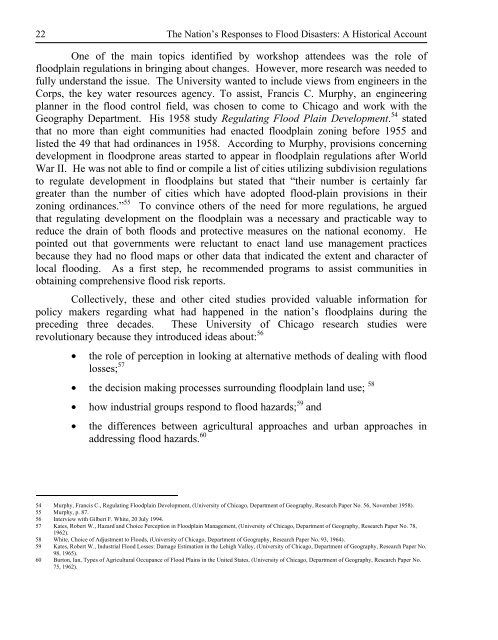The Nation's Responses To Flood Disasters: A Historical Account
The Nation's Responses To Flood Disasters: A Historical Account
The Nation's Responses To Flood Disasters: A Historical Account
You also want an ePaper? Increase the reach of your titles
YUMPU automatically turns print PDFs into web optimized ePapers that Google loves.
22<br />
<strong>The</strong> Nation’s <strong>Responses</strong> to <strong>Flood</strong> <strong>Disasters</strong>: A <strong>Historical</strong> <strong>Account</strong><br />
One of the main topics identified by workshop attendees was the role of<br />
floodplain regulations in bringing about changes. However, more research was needed to<br />
fully understand the issue. <strong>The</strong> University wanted to include views from engineers in the<br />
Corps, the key water resources agency. <strong>To</strong> assist, Francis C. Murphy, an engineering<br />
planner in the flood control field, was chosen to come to Chicago and work with the<br />
Geography Department. His 1958 study Regulating <strong>Flood</strong> Plain Development. 54 stated<br />
that no more than eight communities had enacted floodplain zoning before 1955 and<br />
listed the 49 that had ordinances in 1958. According to Murphy, provisions concerning<br />
development in floodprone areas started to appear in floodplain regulations after World<br />
War II. He was not able to find or compile a list of cities utilizing subdivision regulations<br />
to regulate development in floodplains but stated that “their number is certainly far<br />
greater than the number of cities which have adopted flood-plain provisions in their<br />
zoning ordinances.” 55 <strong>To</strong> convince others of the need for more regulations, he argued<br />
that regulating development on the floodplain was a necessary and practicable way to<br />
reduce the drain of both floods and protective measures on the national economy. He<br />
pointed out that governments were reluctant to enact land use management practices<br />
because they had no flood maps or other data that indicated the extent and character of<br />
local flooding. As a first step, he recommended programs to assist communities in<br />
obtaining comprehensive flood risk reports.<br />
Collectively, these and other cited studies provided valuable information for<br />
policy makers regarding what had happened in the nation’s floodplains during the<br />
preceding three decades. <strong>The</strong>se University of Chicago research studies were<br />
revolutionary because they introduced ideas about: 56<br />
• the role of perception in looking at alternative methods of dealing with flood<br />
losses; 57<br />
• the decision making processes surrounding floodplain land use; 58<br />
• how industrial groups respond to flood hazards; 59 and<br />
• the differences between agricultural approaches and urban approaches in<br />
addressing flood hazards. 60<br />
54 Murphy, Francis C., Regulating <strong>Flood</strong>plain Development, (University of Chicago, Department of Geography, Research Paper No. 56, November 1958).<br />
55 Murphy, p. 87.<br />
56 Interview with Gilbert F. White, 20 July 1994.<br />
57 Kates, Robert W., Hazard and Choice Perception in <strong>Flood</strong>plain Management, (University of Chicago, Department of Geography, Research Paper No. 78,<br />
1962).<br />
58 White, Choice of Adjustment to <strong>Flood</strong>s, (University of Chicago, Department of Geography, Research Paper No. 93, 1964).<br />
59 Kates, Robert W., Industrial <strong>Flood</strong> Losses: Damage Estimation in the Lehigh Valley, (University of Chicago, Department of Geography, Research Paper No.<br />
98, 1965).<br />
60 Burton, Ian, Types of Agricultural Occupance of <strong>Flood</strong> Plains in the United States, (University of Chicago, Department of Geography, Research Paper No.<br />
75, 1962).
















